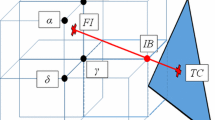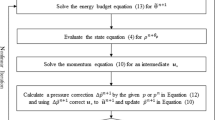Abstract
The two-dimensional inviscid hydrostatic primitive equations of the atmosphere with humidity and saturation are considered in the presence of topography. The model studied here describes the dynamics of the air or water in order to approximate global atmospheric flows. The heart of the paper is to derive a new set of transformed inviscid primitive equations using a version of the terrain-following coordinate systems and to develop an accurate numerical scheme to the equations. In this regard, a fully discrete numerical algorithm based on a Godunov-type finite volume method is proposed and its convergence tested. We then use this algorithm to simulate the flows above a mountain using the terrain-following coordinate system with a dynamic bottom pressure.






Similar content being viewed by others
References
Arakawa, A., Konor, C.: Vertical differencing of the primitive equations based on the Charney–Phillips grid in hybrid & sigma-p vertical coordinates. Mon. Weather Rev. 124(3), 511–528 (1996)
Arakawa, A., Suarez, M.: Vertical differencing of the primitive equations in sigma coordinates. Mon. Weather Rev. 111(1), 34–45 (1983)
Bousquet, A., Chekroun, M., Hong, Y., Temam, R., Tribbia, J.: Numerical simulations of the humid atmosphere above a mountain. Math. Clim. Weather Forecast. 1, 96–126 (2016)
Bousquet, A., Gie, G.-M., Hong, Y., Laminie, J.: A higher order finite volume resolution method for a system related to the inviscid primitive equations in a complex domain. Numer. Math. 28, 431–461 (2014)
Chen, Q., Shiue, M.-C., Temam, R.: The barotropic mode for the primitive equations. J. Sci. Comput. 45(1–3), 167–199 (2010)
Chen, Q., Shiue, M.-C., Temam, R., Tribbia, J.: Numerical approximation of the inviscid 3D primitive equations in a limited domain. ESAIM Math. Model. Numer. Anal. 46(3), 619–646 (2012)
Cao, C., Titi, E.: Global well-posedness of the three-dimensional viscous primitive equations of large scale ocean and atmosphere dynamics. Ann. Math. 166, 245–267 (2007)
Chen, Q., Temam, R., Tribbia, J.J.: Simulations of the 2.5D inviscid primitive equations in a limited domain. J. Comput. Phys. 227(23), 9865–9884 (2008)
Durran, D.R., Klemp, J.B.: A compressible model for the simulation of moist mountain waves. Mon. Weather Rev. 111(12), 2341–2361 (1983)
Dwoyer, D.L., Sanders, J.A., Ghil, M., Verhulst, F., Hussaini, M.Y., Childress, S., Voigt, R.G.: Topics in Geophysical Fluid Dynamics: Atmospheric Dynamics, Dynamo Theory, and Climate Dynamics. Applied Mathematical Sciences, vol. 58-60. Springer, Berlin (1985)
Gill, A.E.: Atmosphere-ocean dynamics. Academic Press, New York (1982)
Gal-Chen, T., Somerville, R.: On the use of a coordinate transformation for the solution of the Navier–Stokes equations. J. Comput. Phys. 17, 209–228 (1975)
Garvert, M.F., Smull, B., Mass, C.: Multiscale mountain waves influencing a major orographic precipitation event. J. Atmos. Sci. 64(3), 711–737 (2007)
Haltiner, G.J.: Numerical Weather Prediction. Wiley, New York (1971)
Haney, R.L.: On the pressure gradient force over steep topography in sigma coordinate ocean models. J. Phys. Oceanogr. 21(4), 610–619 (1991)
Haltiner, G.J., Williams, R.T.: Numerical Prediction and Dynamic Meteorology, 2nd edn. Wiley, New York (1980)
Jiang, G.-S., Shu, C.-W.: Efficient implementation of weighted ENO schemes. J. Comput. Phys. 126(1), 202–228 (1996)
Kasahara, A.: Various vertical coordinate systems used for numerical weather prediction. Mon. Weather Rev. 102(7), 509–522 (1974)
Kurganov, A., Levy, D.: Central-upwind schemes for the Saint-Venant system. M2AN 36(3), 397–425 (2002)
Kobelkov, G.: Existence of a solution ‘in the large’ for the 3D large-scale ocean dynamics equations. C. R. Math. Acad. Sci. Paris 343(4), 283–286 (2006)
Kurganov, A., Petrova, G.: Central-upwind scheme on triangular grids for hyperbolic system of conservation laws. Numer. Methods Partial Differ. Equ. 22(3), 536–552 (2005)
Klemp, J.B., Skamarock, W.C., Fuhrer, O.: Numerical consistency of metric terms in terrain-following coordinates. Mon. Weather Rev. 131(7), 1229–1239 (2003)
Klemp, J., Skamarock, W., Fuhrer, O.: Numerical consistency of metric terms in terrain-following coordinates. Mon. Weather Rev. 131(7), 1229–1239 (2003)
Kurganov, A., Tadmor, E.: New high-resolution central schemes for nonlinear conservation laws and convection–diffusion equations. J. Comput. Phys. 160(1), 241–282 (2000)
LeVeque, R.J.: Finite Volume Methods for Hyperbolic Problems. Cambridge Texts in Applied Mathematics. Cambridge University Press, Cambridge (2002)
Lin, S.-J.: A finite-volume integration method for computing pressure gradient force in general vertical coordinates. Q. J. R. Meteorol. Soc. 123(542), 1749–1762 (1997)
Lions, J.-L., Temam, R., Wang, S.H.: New formulations of the primitive equations of atmosphere and applications. Nonlinearity 5(2), 237–288 (1992)
Liu, J.-G., Wang, C.: Positivity property of second order flux-splitting schemes of compressible Euler equations. Discrete Contin. Dyn. Syst. Ser. B 3, 201–228 (2003)
Liu, J.-G., Wang, C.: A fourth order numerical method for the primitive equations formulated in mean vorticity. Commun. Comput. Phys. 4, 26–55 (2008)
Oliger, J., Sundström, A.: Theoretical and practical aspects of some initial boundary value problems in fluid dynamics. SIAM J. Appl. Math. 35(3), 419–446 (1978)
Pacanowski, R.C., Gnanadesikan, A.: Transient response in a z-level ocean model that resolves topography with partial cells. Mon. Weather Rev. 126(12), 3248–3270 (1998)
Phillips, N.A.: A coordinate system having some special advantages for numerical forecasting. J. Meteorol. 14(2), 184–185 (1957)
Petcu, M., Temam, R.M., Ziane, M.: Some mathematical problems in geophysical fluid dynamics. In: Handbook of Numerical Analysis. vol. XIV. Special Volume: Computational Methods for the Atmosphere and the Oceans, volume 14 of Handbook of Numerical Analysis, pp. 577–750. Elsevier/North-Holland, Amsterdam (2009)
Rousseau, A., Temam, R., Tribbia, J.: Numerical simulations of the inviscid primitive equations in a limited domain. In: Calgaro, C., Coulombel, J.F., Goudon, T. (eds.) Analysis and Simulation of Fluid Dynamics. Advances in Mathematical Fluid Mechanics, pp. 163–181. Birkhäuser, Basel (2007)
Rogers, R.R., Yau, M.K.: A Short Course in Cloud Physics, 3rd edn. Pergamon Press, Oxford (1989)
Simmons, A.J., Burridge, D.M.: An energy and angular-momentum conserving vertical finite-difference scheme and hybrid vertical coordinates. Mon. Weather Rev. 109(4), 758–766 (1981)
Schar, C., Leuenberger, D., Fuhrer, O., Luthi, D., Girard, C.: A new terrain-following vertical coordinate formulation for atmospheric prediction models. Mon. Weather Rev. 130(10), 2459–2480 (2002)
Samelson, R., Temam, R., Wang, C., Wang, S.: Surface pressure Poisson equation formulation of the primitive equations: numerical schemes. SIAM J. Numer. Anal. 41, 1163–1194 (2003)
Shaw, J.: Comparison of terrain-following and cut-cell grids using a nonhydrostatic model. Mon. Weather Rev. 144(6), 2085–2099 (2016)
Temam, R., Tribbia, J.: Open boundary conditions for the primitive and Boussinesq equations. J. Atmos. Sci. 60(21), 2647–2660 (2003)
Wang, C.: Convergence analysis of the numerical method for the primitive equations formulated in mean vorticity on a Cartesian grid. Discrete Contin. Dyn. Syst. Ser. B 4, 1143–1172 (2004)
Zhang, Y.J., Ateljevich, E., Yu, H.-C., Wu, C.H., Jason, C.S.: A new vertical coordinate system for a 3d unstructured-grid model. Ocean Model. 85, 16–31 (2015)
Acknowledgements
Y.H. gratefully acknowledges support from the Research Fund of San Diego State University. R.M.T. gratefully acknowledges support from the National Science Foundation through grant No. DMS-1510249 and from the Research Fund of Indiana University.
Author information
Authors and Affiliations
Corresponding author
Additional information
Publisher's Note
Springer Nature remains neutral with regard to jurisdictional claims in published maps and institutional affiliations.
Rights and permissions
About this article
Cite this article
Bousquet, A., Hong, Y., Temam, R. et al. Numerical Simulations of the Two-Dimensional Inviscid Hydrostatic Primitive Equations with Humidity and Saturation. J Sci Comput 83, 36 (2020). https://doi.org/10.1007/s10915-020-01215-y
Received:
Revised:
Accepted:
Published:
DOI: https://doi.org/10.1007/s10915-020-01215-y




